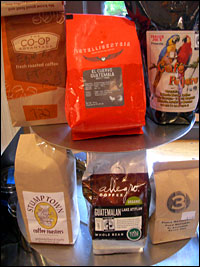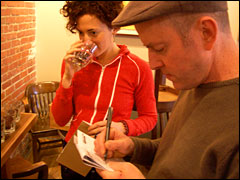Coffee surely counts as one of our more problematic daily pleasures.
Java-slugging Grist readers should know that coffee deserves some of the blame for global warming. A lucid account by University of California-Santa Cruz historian Chris Brooks tells the sad story, which encompasses slave labor, razed rainforests, and the colonialism of the 19th century.

Six competitors line up for their mug shot.
Coffee remains a troublesome beverage today; it deeply taxes resources in places where it’s grown, and its vast footprint tends to be concentrated in impoverished areas where land might be better used growing food for local consumption. Worse still, giant corporations — not the farmers who grow it — tend to benefit most from coffee’s status as the globe’s second most-traded commodity after crude oil. Four companies (Sara Lee, Procter & Gamble, Nestle, and Kraft) buy and roast fully half of the globe’s coffee. They use their market power to hold prices down for growers while profitably selling cheap swill in supermarkets.
But coffee can also be part of a diverse mix of crops, bringing welcome foreign exchange into areas that also grow food for nearby people to eat. And happily, coffee cultivated in traditional smallholder fashion — under a canopy of plants that produce other crops — tends to be the best tasting. Responsible consumers should try to limit their business to such producers.
GRIST’S PICK
Counter Culture
Direct trade
$17 per pound
I rationalize my own three-cups-a-day habit by viewing coffee as a prized, almost sacred substance. I try to slow down and taste, not just gulp. In that spirit, I offer the first Grist coffee tasting.
To limit the cupping to ethical coffees, I used two methods. First was to rely on the major certifications: 1) Fair Trade, which monitors how farmers treat their workers and pays growers a set premium over the market price (among other measures); 2) organic, which ensures that no synthetic chemicals were used in production; and 3) shade-grown, which rewards growers who grow their coffee under a canopy, providing habitat for birds.
My second method for selecting ethical coffees was to look for mid-sized regional roasters that practice what’s known as “direct trade”: Ignoring the major certifications, these roasters buy directly from small farmers who uphold high ecological and social standards, paying a hefty premium for coffee of the highest quality.
There’s an argument brewing between direct-trade and certification-oriented roasters over which delivers the more ethically robust product. I’ll turn to that debate in future articles. For now, let’s get to the tasting.
To narrow the candidates further, I looked for coffees from a celebrated, well-established growing region: Guatemala. When I couldn’t get my hands on Guatemalan beans from a roaster I wanted to feature, I chose a nearby origin. At their best, Guatemalan coffees (warning: coffee-nerd-speak coming) deliver bright acidity and a cherry-like sweetness that can turn chocolaty on the finish.
I was lucky enough to hold the tasting at 3 Cups, a coffee temple in Chapel Hill, N.C. 3 Cups manager and coffee buyer Badi Bradley joined me on the tasting panel and ensured that we followed proper procedures. Our other panelist was Sara Safransky, a grad student in city and regional planning at the University of North Carolina. Before launching her academic career, Sara joined me as one of the founders of Maverick Farms, where we worked side by side in the kitchen and in the field for three years, often propelled by strong coffee. Sara’s got a famously picky palate.

Compost aroma with a chocolaty finish?
We cupped our six coffees “blind,” i.e., without knowing what they were. In a professional cupping, you first place the freshly ground beans in a cup and sniff. Then you add hot water, and sniff again. After letting it steep a few minutes, you “break” the floating grounds with a spoon and sniff yet again. Then you clear the grounds off the top of the cup, and begin frantically scooping little spoonfuls of coffee out and slurping them, letting the oxygen open up flavor compounds. Thus we sniffed, slurped, frowned in concentration — and eventually got dizzyingly high on caffeine. (Not so much Badi, though; a professional, he knew enough to spit.) We each rated the brews on a scale from one to 10, then combined our scores. Here is what we found.
1) Roaster: Equal Exchange
Origin: Guatemalan
Certifications: Fair Trade, organic, and shade-grown
Roast date: Unknown
Roast: Medium
Price: $10/pound (Weaver Street Market, Carrboro, N.C.)
Total score: 18 points (out of 30)
I chose an Equal Exchange coffee because it’s a staple of health-food stores and food co-ops nationwide. To be honest, I wasn’t expecting much from it. I got it from a bin at a food co-op, and had no idea how long it had been sitting there (roasted coffee is a highly perishable product that begins to dramatically lose flavor about two weeks after roasting).
It turned out not to be stale at all (when you pour hot water over freshly roasted ground coffee, it will froth and bubble in a way that makes it almost seem alive). It delivered: a bright, citrusy nose and the kind of zip on the palate I expect from Guatemala. I gave it 7 points, and would drink it again. Badi (6 points) found it drinkable, while Sara — who turned out not to be a big fan of the Guatemalan/Central American flavor profile — gave it a 5.
2) Roaster: Stumptown
Origin/blend: Guatemala Finca El Injerto-pacamara varietal
Certifications: Direct trade
Roast date: Days before the cupping
Roast: Medium
Price: $14.50/pound (mail order)
Total score: 20 points (out of 30)
Of all the coffees in our lineup, I was most excited to try this one, since I had never sampled the wares of Stumptown, a much-respected roaster out of Portland. It didn’t disappoint. I couldn’t stop sniffing this one; it had a sparkly aroma that contained oranges and lemons and cherries (Badi found tangerines). On the palate it was racy and balanced, starting bright and ending on a long chocolate note. “Bright citrus, brown sugar, [and] almond,” wrote Badi. I could drink a lot more of this, I thought — and in fact have been since the tasting. I gave it 8 points, as did Badi (it was his favorite of the bunch). Sara, the scourge of Guatemalan coffee, gave it 4.
3) Roaster: Trader Joe’s
Origin: A “blend of Central American beans”
Certifications: Fair Trade, organic, and shade-grown
Roast date: Unknown
Roast: Dark
Price: $7.49/pound (Trader Joe’s, Chapel Hill, N.C.)
Total score: 1 point (out of 30)
I wanted a coffee from Trader Joe’s because of the retailer’s national footprint, and because of its reputation for delivering high quality at a reasonable price. The outlet I went to didn’t offer a straight Guatemalan, so I chose this blend — which meant our cupping wasn’t really a fair forum for this selection, since all of the other coffees are from unblended single-origins. Also, this was the only dark roast in the bunch. When you roast coffee past a certain point, you begin to destroy the flavors inherent in the bean, and start delivering a generic “toasty” flavor.
This coffee was a disaster. First, it was absolutely stale (Trader Joe’s offers no information on roast date). When we poured hot water over the grounds, there was zero bubbling — a sure sign a coffee has passed its drink-by date. It smelled of road tar, moldy oranges, and “compost — not the sweet-smelling kind,” said Sara. On the palate, it was acrid and “gross” (Sara again). Badi speculated that it might contain robusta, the cheap, lousy varietal favored by mass-market corporate roasters. Coming from the mouth of a coffee professional, that’s a mortal insult.
4) Roaster: Intelligentsia
Origin/blend: Guatemala El Cuervo
Certifications: Direct trade
Roast date: Days before the cupping
Roast: Medium
Price: $13.95/pound (mail order)
Total score: 19 points (out of 30)
Like Stumptown, Chicago-based Intelligentsia is a mid-sized roaster with a cult following among coffee nerds. I had the pleasure of experiencing Intelligentsia several times on a trip to Chicago last summer. Again, I found myself sniffing this one as if I were traipsing through a flowerbed. It offered a complex, winy nose. On the palate, it starts racy and ends smooth, with rich milk-chocolate notes. Badi found it cherryish on the nose, and sweet with jasmine/floral tones on the palate. I gave it 8 points. Badi gave it 7, declaring it a classic example of the Guatemalan type. Unimpressed, Sara gave it 4.
5) Roaster: Counter Culture
Origin/blend: El Salvador, Finca Mauritania Pulp Natural
Certifications: Direct trade
Roast date: Days before the cupping
Roast: Medium
Price: $17/pound (purchased at 3 Cups)
Total score: 23.5 points (out of 30)
Durham, N.C.-based Counter Culture was the third in our cupping’s triumvirate of legendary mid-sized roasters. This one could be suspected of boasting home-field advantage; Badi’s coffeehouse uses exclusively Counter Culture beans, and I consider it to be my local roaster. I couldn’t get my hands on a Counter Culture Guatemalan at cupping time, so I grabbed the closest thing on offer at 3 Cups, this El Salvadoran specimen from the highly regarded Finca Mauritania estate.
Both Badi and I managed to identify this one from the lineup (I had been drinking it over the holidays); it was the only one we accurately guessed. On the nose, it was round, fruity, and irresistible; on the palate, a real mouthful: bright and orange-ish, then moving into a sweet, chocolaty finish. I awarded 9 points, my highest mark of he day. Badi gave it 7.5. And Sara actually liked it — giving it 7 points. By swaying our panel’s hanging judge, this one grabbed our highest score.
6) Roaster: Allegro
Origin/blend: Guatemalan Lago Atitlan
Certifications: Fair Trade, organic, and shade-grown
Roast date: Unknown
Roast: Medium
Price: $12.95/12 oz (purchased at Whole Foods, Chapel Hill, N.C.)
Total score: 18 points (out of 30)

Consumer Reports’ GreenerChoices.org says general shade-grown claims don’t mean much. Instead, look for “Bird Friendly” or “Rainforest Alliance” certified labels, which both require coffee farms to be at least partially shaded. Learn more.
I wanted to get Allegro in because it’s a national brand — available at Whole Foods — and a longtime champion of ethical coffees. I definitely got solid Guatemalan notes from the nose and the palate, but it seemed muted. The bag offered no roast-date information, but it did contain a sell-by date: April 25, 2008 — more than four months after our roasting. It may have been a little on the stale side. Not a bad coffee by any means. Badi found orange/jasmine notes on the nose, and nutty, cherry, tart flavors on the palate. Even Sara got into it, relatively speaking. We all gave it 6 points.
The bottom line: What does all of this tell us? Given the size of the coffee world — scores of roasters vending beans from dozens of origins on several continents — it’s hard to draw major conclusions from six samples. But we can say this: The large-footprint roasters generally held their own against their smaller peers. With the exception, of course, of Trader Joe’s — but the over-roasted, stale “blend of Central American beans” we sampled might not be a fair example of that retailer’s wares. We also learned that freshness matters; it makes sense to buy from sources that telegraph roast dates.
For those who want to try the winning coffee, Counter Culture beans are available at dozens of cafes up and down the East Coast (including New York City’s Ninth Street Espresso and Café Grumpy, and Washington D.C.’s Murky Coffee) and can also be bought online.

